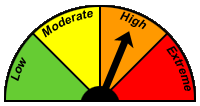Important!
Having a fire extinguisher handy and knowing how to use it may save your home, your possessions and even your life. This is especially true following a major emergency when the fire department will be overwhelmed by the number of calls and may not be able to get to you in time. However, be smart. Knowing when the fire is too big to handle is equally important. Do not endanger yourself or your family by trying to save your home.Escaping a Fire
- Stop, drop and roll – until the clothing fire is out. Running makes the fire burn faster.
- Check closed doors for heat before you open them. Use the back of your hand to feel the top of the door, the doorknob and the crack between the door and doorframe before you open it. Keep your hands safe to climb down ladders and crawl out to safety.
| Hot Door | Cold Door |
| Do not open. Escape through a window or other exit. | Open slowly and ensure fire and/or smoke is not blocking your escape route. |
| If you cannot escape, hang a light-coloured sheet outside the window, alerting firefighters to your presence. | If escape route is blocked, shut the door and use another escape route, such as a window. |
| If clear, crawl low under the smoke to exit. | |
| Use a whistle to draw attention to your plight. | Close doors behind you as you escape to delaythe spread of the fire. |
| Stay out. Do not reenter. Call 9-1-1. | Stay out. Do not reenter. Call 9-1-1. |
Fire Extinguishers
Locate your fire extinguishers where they are readily accessible. When used correctly, they can keep small fires from becoming big ones.
- It is better to have several smaller extinguishers located throughout the house than to have one large one that may be difficult to reach quickly. This is especially important if your home has multiple floors.
- An A:B:C extinguisher is recommended for most types of fires.
- Regularly review the operating instructions as you won’t have time to read them when a fire occurs.
- At least once a year turn your fire extinguisher upside-down, give the bottom a good smack and shake it to keep the chemical powder from caking.
- Check the fire extinguisher gauge to ensure the pressure is at the recommended level. (i.e. in the green zone: not too high and not too low).
Some manufacturers recommend shaking your dry chemical extinguishers once a month to prevent the powder from settling/packing.
Fire extinguishers should be pressure tested (a process called hydrostatic testing) after a number of years to ensure that the cylinder is safe to use. Consult your owner’s manual, extinguisher label or the manufacturer to see when yours may need such testing.
Notice
IMPORTANT: Recharge all extinguishers immediately after use, regardless of how much they were used.Only fight a fire if:
- The fire is small and contained.
- You are safe from toxic smoke.
- You have a means of escape.
- Your instincts tell you it’s OK.






